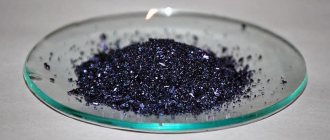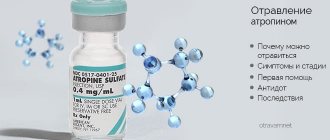Whether it's a dark red liquid, dirty yellow vapor, or brown crystals, bromine is poisonous in any form. Fortunately, dangerous concentrations do not occur in nature. You can only find it in production, where safety precautions are carefully monitored. But there are exceptions everywhere. Despite the fact that bromine poisoning is extremely rare, its symptoms can appear not only at work, but also in everyday life.
Causes of bromine poisoning
People working in the chemical industry are familiar with bromine, a solid, needle-crystalline substance. Poisoning is caused by fumes, turning yellow-gray.
The main causes of bromine intoxication:
- failure to comply with safety rules when working with poisons;
- abuse of medications (Corvalol, Valocordin) containing sodium bromide;
- illiterate use of pesticides for the treatment of garden and berry crops in plots in order to suppress pests
Reference! Inhalation of sodium bromide vapor can cause damage to vital systems (organs) due to the rapid absorption of chemicals into the blood and distribution throughout the body. An overdose of bromine leads not only to intoxication, but also to death.
Description of the medicine
Corvalol is a sedative and sedative.
Available in drops and tablets. It contains menthol and phenobarbital. Many people mistakenly believe that it affects the functioning of the cardiovascular system. Phenobarbital, the main active ingredient of Corvalol, belongs to the group of barbiturates. It is marketed under the name Luminal.
This is a very potent component that relieves convulsive episodes in patients with epilepsy. It can be highly addictive and addictive.
In Corvalol, phenobarbital is present in a small concentration, due to which it provides a slight sedative effect.
Indications for taking Corvalol:
- sleep disorders, insomnia;
- episodes of stressful situations;
- panic attacks;
- nervous overstrain.
Barbiturates, menthol and phenobarbital - these active substances, as well as their use, should be supervised by a specialist. However, they are part of a medicine that is available without a prescription and is sold in every pharmacy - Corvalol. It is no secret that these substances are addictive and addictive.
There is a whole group of medical drug addicts - butyrate, barbiturate. They inject the pure substance into their veins. It cannot be said that this awaits everyone who takes Corvalol, but it is the uncontrolled use of the drug that can cause addiction, and sometimes even death.
Corvalol - drops with a mild sedative, moderate hypotensive and antispasmodic effect. The drug is based on phenobarbital (1.12%) and ethyl ester of a-bromoisovaleric acid (~ 3%).
In the USA and a number of Western European countries, these substances are classified not only as sedatives, but also as psychotropic substances, and are even prohibited for sale. Phenobarbital can be addictive, forcing a person to increase the dose.
In addition, the composition includes peppermint oil, alcohol and distilled water.
Emergency help
Bromine poisoning leads to acute intoxication, so it is important to help the victim in a timely manner. Actions:
- take off your clothes, providing access to fresh air and pure oxygen;
- wipe the body with an alcohol solution;
- serve drink warm milk with soda (1 glass);
- transfer the patient to a salt diet with salt intake (30 g per day);
- carry out alkaline inhalation to relieve the effects of bromism.
In a hospital setting, doctors carry out cleansing therapy with the administration of sodium chloride (IV). Additionally, tablets (Pipolfen, Diphenhydramine) and cardiac medications are prescribed to restore cardiac activity.
How to help the victim?
First of all, you need to call a medical emergency.
Providing first aid comes down to the following actions:
- The poisoned person must be immediately taken out into fresh air; if this is not possible, access to pure oxygen must be provided through an open window.
- If a person is poisoned by bromine vapor or a liquid composition, he must immediately take off his clothes, wipe his skin with an alcohol solution, and put on an oxygen mask (if possible).
- You can give him warm milk and soda to drink.
- Softening alkaline inhalations help relieve the effects of bromism.
- The patient should eat 10-30 g of salt per day with food.
The doctor carries out blood cleansing therapy - sodium chloride is injected intravenously, and the patient is given diphenhydramine and pipolfen in tablets. Cardiac medications help restore cardiac activity.
Therapeutic actions
In the hospital, doctors will identify the degree of bromine intoxication and take urine and blood tests for laboratory testing. Main methods of therapy:
- prescription of medications (Diphenhydramine, Pipolfen), special drugs to restore cardiac function of the heart muscle;
- applying compresses locally to affected areas of the skin;
- administration of glucose solution (40%) using a dropper;
- giving an injection of calcium chloride;
- performing artificial ventilation in case of difficulty breathing.
Reference! Abundant alkaline drinking or inhalation effectively eliminates the effects of bromine. It is recommended to take warm milk with soda in small sips.
Prevention
Preventing bromine poisoning means following simple preventive measures:
- wear a special respirator when working with pesticides;
- Do not neglect dosages when taking medications.
Poisoning from the chemical bromine is rare. However, the initial manifestations cannot be ignored. You need to urgently call an ambulance and be able to take the first action at home.
Current knowledge about the immediate and long-term effects of exposure to neurotoxic substances comes from experimental animal studies and human chamber studies, epidemiological studies of working and retired and/or ill workers, clinical studies and reports, and after large-scale disasters such as those that occurred in Bhopal, where there was a leak of methyl isocyanate, and in Minamata, where there was methyl mercury poisoning.
Exposure to neurotoxic substances may cause immediate effects (acute) and/or late effects (chronic). In both cases, these effects may be reversible and disappear over time once exposure is reduced or stopped, or result in permanent, irreversible damage. The severity of acute and chronic damage to the nervous system depends on the dose of exposure, and here we are talking about both the degree and duration of exposure. Like alcohol or those drugs that are taken recreationally and do not involve addiction, many neurotoxic substances may initially be stimulating, causing a feeling of well-being or euphoria or increased motor function; as the dose increases in quantity and duration of exposure, these same neurotoxins will depress the nervous system. Indeed, anesthesia (a state of stupor or insensibility) is caused by a large number of neurotoxic substances that cause changes in intelligence and depress the central nervous system.
Acute Poisoning Acute effects reflect an immediate reaction to a chemical. The severity of symptoms and resulting damage depend on the amount that reaches the nervous system. With minor exposure, acute effects are mild and transient, disappearing when exposure ceases. Headache, fatigue, feeling lightheaded, difficulty concentrating, feelings of drunkenness, euphoria, irritability, dizziness, and slow reflexes are types of symptoms experienced when exposed to neurotoxic drugs. Although these symptoms are reversible, if exposure is repeated day after day, the symptoms will also recur. Moreover, since the neurotoxic substance is not immediately eliminated from the body, symptoms may persist after work. Recorded symptoms occurring in a specific workplace are highly representative of chemical interference with the nervous system and should be considered a warning sign for potential overdose; Preventive measures should begin to reduce exposure levels.
If the level of exposure is very high, as can be the case with spills, leaks, explosions and other accidents, symptoms and signs of toxicity are debilitating (severe headaches, confusion, nausea, dizziness, lack of coordination, blurred vision, loss of consciousness); if the exposure level is high enough, the effects can be prolonged, possibly leading to coma and death.
Acute pesticide-related disorders often occur among agricultural workers in food-producing countries where large amounts of toxic substances in the form of insecticides, fungicides, nematicides and herbicides are used. Organophosphates, carbamates, organochlorines, pyrethrum, pyrethrins, paraquat and diquat are major categories of pesticides; however, there are thousands of pesticide formulations containing hundreds of different active ingredients. Some pesticides, such as maneb, contain manganese, while others are soluble in organic solvents. In addition to the above-mentioned symptoms, acute poisoning with organophosphates and carbamates may be accompanied by salivation, incontinence, convulsions, muscle twitching, diarrhea, visual disturbances, as well as respiratory distress and high heart rate; all of this is a result of excess levels of the neurotransmitter acetylcholine, which occurs when these substances attack a chemical called cholinesterase. The content of cholinesterase in the blood decreases in proportion to the degree of acute intoxication as a result of exposure to organophosphorus compounds or carbamates.
For some substances, such as organophosphate pesticides or carbon monoxide, acute exposure at high doses can cause long-term impairment of some parts of the nervous system. For the former, numbness and tingling, weakness and imbalance may occur several weeks after exposure, and for the latter, late neurological deterioration may develop with symptoms of confusion, ataxia, motor incoordination and paresis. Repeated acute episodes of high-dose carbon monoxide exposure have been associated with the development of parkinsonism late in life. It is possible that high-dose exposure to certain neurotoxic chemicals may subsequently be associated with an increased risk of neurodegenerative disorders.
Chronic Poisoning Recognition of the dangers of neurotoxic chemicals has led many countries to lower acceptable exposure concentrations. However, for most chemicals, the concentration at which there is no harmful effect over long-term exposure is still unknown. Repeated exposure to low to moderate concentrations of neurotoxic chemicals over many months or years can alter nervous system function in insidious and progressive ways. Constant interference with molecular and cellular processes leads to the fact that neurophysiological and psychological functions undergo slow changes, which in the early stages may go unnoticed, since the nervous system has large reserves and damage can be compensated in the early stages by learning new things.
Thus, the initial injury to the nervous system is not necessarily accompanied by functional impairment and may be reversible. However, as the damage progresses, symptoms and signs, often nonspecific, appear and people may seek medical attention. Finally, the disorder may become so severe that a clear clinical syndrome becomes apparent, usually irreversible.
Figure 7.8 provides a schematic continuum of health impairment associated with exposure to neurotoxic substances. The progression of dysfunction caused by neurotoxic substances depends on both the duration of exposure and the concentration (dose) of the substance, and may be influenced by other workplace factors, individual health status and susceptibility, and lifestyle, especially drinking and exposure to neurotoxic substances. , used in a variety of hobby activities such as adhesives used in furniture assembly or plastic model building, paints and paint removers.
Rice. 7.8 Continuum of deterioration with increasing dose
Various strategies have been adopted to identify neurotoxin-related illness in individual workers and to monitor early neurological decline in workers. Clinical diagnosis is based on a variety of signs and symptoms along with the individual's medical and exposure history; etiologies unrelated to exposure should be systematically excluded. To monitor the early development of dysfunction in workers, a group portrait of dysfunction is important. More often than not, the pattern of dysfunction observed for the entire group is similar to the pattern of dysfunction observed clinically in the disease. This is similar in some ways to assessing early mild changes to get a picture of what is happening in the nervous system. The nature or profile of the early response generally indicates the specificity and mode of action of a particular neurotoxic substance or mixture. In workplaces with potential exposure to neurotoxic substances, monitoring the health of groups of workers may be particularly useful for prevention and workplace interventions to avoid the development of more severe illness (see “Preventing Neurotoxicity at Work”). Workplace studies conducted throughout the world examining workers exposed to specific neurotoxic substances or mixtures of different chemicals have provided valuable information about the early manifestations of nervous system dysfunction in groups of exposed workers.
Early symptoms of chronic poisoning States of altered mood are most often the first symptoms of initial changes in the functioning of the nervous system. Irritability, euphoria, mood swings, extreme fatigue, feelings of hostility, anxiety, depression and tension are among the mood states most often associated with exposure to neurotoxic substances. Other symptoms include memory impairment, difficulty concentrating, headaches, blurred vision, feelings of drunkenness, dizziness, slowness, tingling sensations in the hands or feet, loss of libido, and so on. Although in the early stages these symptoms are usually not so severe as to interfere with work, they do reflect decreased well-being and affect the ability to fully enjoy family and social relationships.
Often, due to the nonspecific nature of these symptoms, workers, employees, and occupational health professionals tend to ignore them and look for causes other than exposure to substances in the workplace. Indeed, such symptoms may contribute to or exacerbate an already difficult personal situation.
In workplaces where neurotoxic substances are used, workers, employees and occupational health and safety personnel should be especially aware of the symptoms of early intoxication that indicate the vulnerability of the nervous system to exposure. Symptom questionnaires have been developed for workplace studies and surveillance of workplaces where neurotoxic substances are used. Table 7.9 provides an example of such a questionnaire.
Table 7.9 Chronic Symptom Checklist
Over the past month, have you experienced the following symptoms:
1. Did you get tired faster than you would expect from your activities? 2. Did you feel dizzy or drowsy? 3. Have you ever found it difficult to concentrate? 4. Did you experience confusion or disorientation? 5. Have you had difficulty remembering? 6. Have your relatives noticed your difficulties in remembering? 7. Have you ever had to take notes so as not to forget something? 8. Have you felt that it is difficult for you to perceive the meaning of what was written in newspapers?
Early motor, sensory and cognitive changes in chronic poisoning With increasing exposure, changes in motor, sensory and cognitive functions may be observed in workers exposed to neurotoxic substances who do not show clinical signs of abnormality. Because the nervous system is complex, and some areas are vulnerable to the effects of certain chemicals while others are sensitive to the effects of a large number of toxicants, a wide range of nervous system functions can be affected by a single toxicant or a mixture of neurotoxins. Reaction time, hand-eye coordination, short-term memory, visual and auditory memory, attention and alertness, right-handedness or left-handedness, vocabulary, shifting attention, grip strength, movement speed, hand stability, mood, color vision, vibrotactile perception, hearing and smell are among the many functions that have been shown to be altered by various neurotoxic substances.
Important information about the type of early deficits caused by exposure was obtained by comparing the productivity of exposed and unexposed workers and as a function of the degree of exposure. Anger (1990) provides an excellent overview of neurobehavioral research in the workplace up to 1989. Table 7.10, adapted from this article, provides an example of the type of neurofunctional deficits that have been consistently observed in groups of active workers exposed to the most commonly encountered neurotoxic substances.
Table 7.10 Persistent neurofunctional effects of exposure to some leading neurotoxicants in the workplace
Bromine poisoning often occurs when working with this substance. It refers to poisons. Used in various areas of life. Poisoning with such a substance can be acute or chronic. What signs should you pay attention to and how can you help a person in this situation?
Possible complications
If you have Corvalol in your home medicine cabinet, you should know how dangerous this drug is. An overdose of Corvalol can lead to severe disruptions in the functioning of the body and death. In large doses it causes intoxication and affects internal organs and the nervous system.
The list shows what will happen to the body if you drink a lot of this medicine:
- Acute renal failure. Phenobarbital and other barbiturates are excreted from the body by the kidneys, and at high concentrations, they may not be able to cope.
- Heart failure. A large dose of Corvalol slows down the rate of heart contractions, slows the pulse, and can cause it to stop.
- Suppression of the nervous system, which can manifest itself as paralysis and the development of a coma.
- Death. Death occurs due to kidney failure or cardiac arrest.
Severe degrees of overdose with Corvalol are quite dangerous. They can be fatal, even with timely medical care.
An overdose of Corvalol is often complicated by pneumonia and impaired renal function. In the long term, neurological disorders (depression, unsteady gait) may be observed, which are caused by toxic and hypoxic encephalopathy.
In older people, chronic overdose can cause:
- reducing reaction speed;
- memory impairment;
- difficulty thinking;
- impaired coordination of movements.
All of the above often leads to falls in older people, which can lead to fractures.
An overdose of the drug can lead to serious complications in the body. They are mainly determined by the dosage of the medicine taken and the timeliness of first aid.
Consequences of poisoning:
- dermatitis of varying degrees;
- disruption of the central nervous system;
- headache;
- heart or kidney failure;
- heart attack or stroke;
- paralysis;
- breathing problems;
- death.
Corvalol is a drug that should be used with extreme caution. The barbiturates included in its composition are addictive.
This threatens with serious consequences. Therefore, in a number of countries, medicines containing these substances are generally prohibited from import.
Corvalol is commercially available today, so it continues to be used in the old fashioned way for heart pain and severe feelings. Before buying the product, you should consult your doctor.
Perhaps it is not at all what you need in your case.
Corvalol is a mild sedative, moderate antispasmodic and hypotensive agent. The correct dose is 15-30 drops three times a day. Drink with water, drop on sugar. What happens if this dose is exceeded? Can an overdose of Corvalol kill? And after what dose do unpleasant consequences occur?
Phenobarbital is the basis of the drug. Bromisovalleric acid in the form of ethyl ester is an excipient. Caustic sodium. Peppermint oil. Distilled water.
Phenobarbital is a chemical compound with a sedative effect. There is very little of it in the preparation. It is addictive, which means that the dose has to be increased all the time. Bromisovaleric acid and peppermint oil enhance the effects of phenobarbital.
Ethyl bromizovallerianate is also not a completely harmless substance. It contains bromine, which causes poisoning if taken for a long time. If the dose is significantly exceeded, the consequences can be severe:
- pulmonary diseases;
- unmotivated depression;
- allergies of unknown etiology;
- clarity of consciousness disappears;
- apathy.
In case of Corvalol poisoning, the consequences can be very serious. Starting from severe dermatitis to acute respiratory, cardiac and renal failure.
The largest number of deaths among drug poisonings is observed precisely from drugs containing Phenobarbital and other long-acting barbituric acid derivatives.
The consequences are largely determined by the dose of the substance taken, the severity of intoxication, and the timeliness of treatment measures.
If a person accidentally or purposefully drinks these drops, he can become intoxicated. By poisoning with Corvalol, the patient puts his heart, kidneys, liver and lungs at risk. Possible death.
The effectiveness of therapeutic measures depends on the phase of poisoning and the timeliness of medical care. The consequences of poisoning also include skin damage (dermatitis) and bedsores.
Bromine toxicity
Bromine is a dark red substance in the liquid state. In solid form it turns into crystals with a red-brown tint. It has good volatility, vapors are no less toxic than liquids. If it comes into contact with the skin, it causes a severe burn.
Used in the chemical, leather, and medical industries.
An overdose of bromine causes disruption of the functioning of all organs and systems. The human condition and further consequences of poisoning depend on the concentration of the toxic substance. In case of severe poisoning, death may occur as a result of pulmonary edema.
Clinical picture of Corvalol poisoning
In case of acute overdose of Corvalol, symptoms and consequences are determined by the amount of medication taken. It is important to note that the clinical picture has three main degrees of severity.
- Mild form of poisoning. In such a situation, weakness and excessive drowsiness, apathy, and lethargy appear. During periods of wakefulness, one may notice slurred and vague speech, irritability and absent-mindedness, and decreased muscle strength. Having discovered such signs, it is important to urgently take the necessary measures to save the victim, which will be discussed below.
- The average severity of intoxication is characterized by pathologically long sleep. It is very difficult to wake up a poisoned person, but if he wakes up, he goes back to bed and falls asleep safely. In addition, drooling is observed, muscle weakness is expressed, and sometimes incomplete paralysis and paresis develop. Blood pressure decreases, very little urine is released, and the pupils dilate.
- Severe intoxication is a barbituric coma. The victim is unconscious, breathing is impaired, and reflexes are difficult to determine. The development of acute cardiovascular failure is possible, which is manifested by the development of hypotension, artymia, cyanosis of the skin, and the presence of wheezing in the lungs. In the absence of intensive therapy, pulmonary edema develops, which leads to death.
Causes and symptoms
Why does bromine overdose occur? There are certain reasons for such intoxication.
- Failure to comply with safety regulations for working with bromine in production. Any actions with this substance must be carried out in special protective clothing and a gas mask.
- Careless use of insect repellents containing bromine in the garden. In this case, poisoning can occur both in the person who processed the plants and in the person who then consumed these plants as food.
- The drug sodium bromide, used in psychiatry, should only be prescribed by a doctor. When self-therapy with this drug, a dosage violation often occurs, resulting in intoxication.
- Medicines such as Corvalol and Valocordin also contain bromine, or rather its compound. Both of these drugs are over the counter, so people often buy them and use them for self-treatment. But not everyone knows that an overdose of these drugs can negatively affect the body’s condition and even cause death.
Thus, bromine intoxication can happen to almost any person if he does not follow safety precautions or engages in self-therapy.
What should you look for to identify poisoning with this substance? In case of an acute overdose of bromine, symptoms appear quite quickly.
- My head is spinning
- Attacks of suffocation occur
- If it comes into contact with the skin, it will burn and cause severe itching.
- Poisoning with bromine vapor causes a severe runny nose,
- Tears are flowing
- There is a severe cough, shortness of breath,
- The tongue turns brown
- Lymph nodes suffer.
In addition, a person experiences nausea and intestinal upset. The stool becomes coffee-colored with an admixture of mucus.
Bromism - what is it: symptoms, treatment
Bromine is a poisonous chemical. It is widely used in medicine and in various industries. Poisoning with this substance can be both acute and chronic. In this article, we examined in detail bromine poisoning, its causes, clinical manifestations, components of treatment and first aid.
Reasons for the development of poisoning
Bromine is a toxic substance. You can become poisoned by inhaling the fumes or ingesting it. Once on the surface of the skin or mucous membranes, it can cause a chemical burn.
Doctors distinguish two forms of poisoning with this chemical: acute and chronic. Acute intoxication develops with immediate massive contact with a chemical. With prolonged use of bromine or when working with it, bromism develops - this is a chronic poisoning in which the nervous system and all internal organs suffer.
The causes of bromine poisoning are listed below.
- Self-administration of sodium bromide. This medication is used in psychiatry in the treatment of neuroses and depressive conditions. Uncontrolled treatment with this sedative leads to chronic poisoning, bromism. The dose of sodium bromide should be calculated by the attending physician individually for each patient.
- Violation of safety rules when working with bromine. If its concentration in the air exceeds 0.01%, acute poisoning develops.
- Treating plants with pesticides that contain bromine. At the same time, people who work with these substances and people who eat plants grown on bromine-treated soil can become poisoned.
Please note that, according to safety standards and regulations, you can only work with bromine in a gas mask or a special respirator. All skin and mucous membranes must be covered with a protective suit.
Features of the clinical course of poisoning
Symptoms of bromine poisoning depend on the severity of the process. Chronic and acute intoxication differ from each other in clinical manifestations. The symptoms of bromine poisoning are discussed below.
Signs of acute poisoning
Acute intoxication most often develops during inhalation of bromine fumes. Symptoms increase rapidly. When the bromine concentration increases to 0.02%, acute poisoning develops, which can be fatal.
Symptoms of acute bromine intoxication:
- lacrimation;
- bouts of dry cough;
- shortness of breath of a mixed nature;
- suffocation;
- tachycardia - rapid heartbeat;
- nose bleed;
- impaired consciousness and the appearance of convulsive attacks.
Symptoms of bromism
Chronic bromine intoxication is no less dangerous for humans than acute poisoning. Serious changes develop in the nervous tissues and internal organs, leading to a malfunction in the functioning of the entire organism. Clinical signs of bromism include:
- pale skin (develops due to anemia);
- rapid and unmotivated weight loss;
- apathy, drowsiness, indifference to everything;
- menstrual irregularities in women, erection problems in men;
- decreased libido;
- impaired mental capacity, memory loss;
- the appearance of blood streaks in the stool;
- hand tremors;
- staggering gait, poor coordination of movements;
- the appearance of compactions and nodules on the skin;
- inflammation of the lymph nodes.
What to do in case of acute bromine poisoning
If a person begins to develop symptoms of acute bromine intoxication, he should immediately be taken out of the contaminated room into fresh air.
Please note that when removing a victim from a bromine-contaminated room, you need to take care of your own safety. Put on a gas mask or respirator and only then enter the danger zone.
After taking the patient out into the fresh air, call emergency medical help. If there are several injured people, do not forget to mention this when calling doctors.
Before paramedics arrive, try to calm the victim. Give him water or sweet tea to drink. Wash it with plain water and rinse your mouth.
If a person loses consciousness before paramedics arrive, place him on a hard surface and turn his head to the side. Monitor his breathing and pulse, and when they stop, begin chest compressions.
EMS doctors will provide first aid, they will inject him with drugs that regulate the functioning of the heart and breathing, and connect him to an oxygen cylinder. Further treatment will be carried out in the intensive care unit.
Treatment of bromism
When the first signs of chronic bromine poisoning appear, you should immediately stop contact with it. If you are taking sedatives that contain bromine, stop taking them. Then you should seek help from your local physician or the doctor who prescribed you sodium bromide.
Treatment of the initial stage of bromine consists of diet and avoidance of repeated exposure to bromine. In severe cases of poisoning, therapy consists of treating the consequences of intoxication. Women are sent for consultation to a gynecologist who treats dysmenorrhea (menstrual irregularities).
Bromine poisoning can be acute or chronic. When the first symptoms of bromine intoxication appear, you should immediately seek medical help. Bromine primarily affects the nervous system. Bromism is accompanied by a decrease in memory and mental abilities. All these changes are correctable and can be treated by a doctor. Self-medicating bromine intoxication is dangerous; only a doctor, after examining the patient, will be able to objectively assess his condition and prescribe individual correct treatment.
otravlenye.ru
Chronic poisoning
Chronic poisoning occurs as a result of constantly exceeding the dosage of bromine. This pathology is called bromism. It poses no less danger to humans. What signs indicate a permanent overdose?
- Pale skin,
- Sharp weight loss with no change in diet,
- Apathy, lack of interest in life,
- Disorders of the reproductive system in women and men,
- Problems with memory, intelligence,
- The presence of bloody inclusions in the stool,
- Hand trembling
- Coordination problems
- Inflammatory processes in the lymph nodes.
Such signs develop gradually, but people whose activities are related to bromine should pay attention to their very first manifestations.
Overdose symptoms
When combined with alcohol, Corvalol can cause severe disorders. In terms of compatibility with alcohol, the drug received 3 points out of 5 possible.
That is, such a combination can pose a threat to life. If you immediately drink alcohol and Corvalol, an inhibitory effect occurs on the nervous system.
This leads to impaired coordination, depression and other mental disorders that do not go away for a long time.
Secondly, metabolism increases due to the synthesis of certain enzymes in the liver. This leads to disruption of the organ and an increase in the concentration of alcohol in the blood, which causes intoxication. Alcohol and Corvalol enhance each other's effects, and this creates a double burden on the body.
Alcohol enhances the effect of phenylbarbital.
In case of Corvalol poisoning, symptoms can be mild, moderate and severe.
Signs of Corvalol poisoning are divided according to severity. Mild symptoms include hypersomnia (a condition where a person is drawn to sleep for no reason), impaired concentration, slurred speech and weakness throughout the body.
Corvalol poisoning occurs when the daily dose exceeds 150 drops; for elderly and weakened people and children, the toxicity threshold is much lower. The lethal dose ranges from 0.1 to 0.3 g per kilogram of weight, that is, about 20 g of the drug. Overdose may cause mild, moderate or severe symptoms.
In mild cases of poisoning, general weakness and drowsiness are noted. When the patient does not sleep, he is lethargic, absent-minded, and his speech is slow and slurred. This condition may resolve without consequences if appropriate measures are taken and the drug is discontinued.
The symptoms of this condition are alarming: a pathologically prolonged state of sleep, it is difficult to wake the person. Even when trying to sit the sleeping person down, he does not wake up or immediately falls asleep again. There is drooling. Muscle weakness is expressed quite clearly, sometimes to a state close to paralysis. Reduced blood pressure. The amount of urine is very small. The pupils are almost always dilated.
Medical first aid and treatment
If a person shows signs of bromine poisoning, then it is necessary to take action as quickly as possible and provide him with the necessary assistance.
- It is necessary to provide the victim with access to clean air and remove or remove him from the room.
- Unfasten all constrictive clothing on him and calm him down.
- If bromine gets on your skin, wash it with water and then wipe it with alcohol.
- A poisoned person can be given milk and soda to drink to neutralize the effect of the substance.
- If poisoning occurs through the oral cavity, the person is given gastric lavage and given water to drink in small portions.
- You can give the patient sorbents to drink to reduce the degree of absorption.
- You can also use enemas for better cleansing.
Next, the victim must be transferred to a medical facility to provide the most complete assistance. Treatment is carried out in a hospital. Various techniques are used to restore the body's functioning.
- For bromine poisoning, bemegride is used as an antidote.
- Artificial ventilation is performed.
- Various medications are prescribed to restore the functioning of all body systems.
- Women should undergo examinations by a gynecologist to restore the functionality of the reproductive system.
- If necessary, vitamin therapy is used.
Therapy is carried out until the person recovers completely.
Consequences of bromine poisoning
What are the risks for a person if they overdose on bromine? Such intoxication negatively affects the entire body.
The most serious consequence is death, which is quite possible in the absence of the necessary help. In addition, poisoning can cause exacerbations in the future and disruption of brain activity. People often have problems with memory and remembering.
To avoid an overdose of bromine, people working with this substance must follow all safety measures, work in special clothing, and wear a gas mask or respirator. You should also not abuse medications such as Corvalol and Valocordin. They should only be used following the instructions for use.
Bromine poisoning does not happen very often. In most cases this happens in production. However, there is also the possibility of household intoxication. Care must be taken when working with pest control products and medicines. In addition, such substances should be stored out of the reach of children.
Toxic dose of medication
As mentioned earlier, Corvalol can cause general poisoning of the body. A similar effect is provoked by the long-acting barbiturate phenobarbital.
Many patients are interested in the question of how many drops are needed to provoke intoxication. The toxic dose of the drug is 150 drops per 24 hours.
It causes poisoning in elderly patients, children, and people with impaired renal function. Most often, patients exceed the dosage during stressful conditions or anxiety syndrome.
The lethal dose of the drug is from 0.1 to 0.3 g/1 kg, on average 20 g of the drug. Lethal outcome is caused by a dose of 100 mg of phenobarbital per 1 kg of weight.
Video: everything about bromine - educational
In the liquid state, bromine has a dark red consistency; when it turns into a solid form, the crystals become brown. In contact with the surface of the skin, bromine causes a chemical burn, so safety precautions must be observed when working with the chemical.
Bromine belongs to the category of toxic substances that have a negative effect on all human organs. In case of direct contact with the chemical composition, it is necessary to wear a gas mask and special clothing.
Causes and signs of poisoning
Bromine overdose most often occurs due to the negligence of people who do not follow safety rules at work or self-prescribe medications.
- Uncontrolled use of medications that contain bromine. The well-known drugs Valocordin and Corvalol, which contain this chemical substance, are available for free sale. It is not uncommon for people to start taking sedatives at the slightest worry, without even realizing the possible side effects. Sodium bromide is widely used in psychiatry, which causes poisoning in case of overdose.
- Use of bromine-containing pest control agents in agriculture. Not only the person processing the plants, but also consumers of vegetables and fruits can become poisoned.
- Violation of safety regulations when working with chemicals in production. Poisoning with bromine vapor is no less dangerous than direct contact with the toxic composition.
Thus, a chemical compound causes poisoning only if used incorrectly; compliance with all safety standards will avoid serious consequences.
The symptoms of bromine poisoning are difficult to ignore - after inhaling the vapors of a toxic substance, the victim experiences the following specific signs of poisoning.
- Difficulty breathing air.
- Dizziness.
- Paroxysmal cough, shortness of breath.
- Intensive secretion of salivary and lacrimal glands.
- When the solution gets on the skin, a burn mark appears and severe itching occurs.
- Inflammation of the lymph nodes.
- Nausea, vomiting.
- Diarrhea. The stool becomes dark brown in color.
If these symptoms appear, the victim should seek medical help.
What is bromine and how does it affect humans?
Bromine (Br) is located in group 7 of chemical elements on the periodic table. This is a liquid halogen that has a pungent odor and a brown color that varies depending on the lighting from dark red to almost black. It is quite toxic, and poisoning can occur both by inhaling the vapors and by getting it inside or on the skin.
We recommend reading: How gastritis is transmitted: is it possible to become infected through a kiss or by inheritance?
At the same time, the substance is contained in the human body, and its lack leads to health problems, including developmental delays in children, nervous disorders and insomnia in adults, anemia, and spontaneous abortion.
Therefore, it is necessary to comply with the permissible consumption standards for bromine-containing drugs, taking into account the fact that a certain amount of the element is contained in water and food products, such as nuts, legumes, dairy products and sea fish.
The daily requirement of bromine for a healthy person is from 0.8 to 1 gram. Its excess poses a serious health hazard.
Bromine poisoning: chronic
Symptoms of chronic poisoning:
- Constant fatigue, apathy to what is happening around.
- Sudden loss of body weight with no change in diet.
- Pale skin.
- Dysfunction of the reproductive system in men and women, lack of attraction to a partner.
- The occurrence of memory problems.
- Loss of coordination, trembling of limbs.
- Inflammatory process in the lymphatic system.
Chronic bromism requires mandatory treatment, which first begins with stopping contact with the chemical.
First aid and treatment
First aid for poisoning:
- The patient needs to provide an influx of fresh air - take him out into the fresh air or open a window. Constrictive clothing should be removed.
- If bromine gets on your skin, wash the affected area with water and then treat it with alcohol.
- If bromine poisoning occurs through the mouth, you should immediately rinse your stomach with plenty of water.
- Sorbents will help reduce the absorption of toxic substances: activated carbon, Enterosgel or Smecta.
After providing emergency care, the patient must be sent to a hospital to provide qualified medical care.
If the victim is unconscious, he should not be left unattended until the emergency team arrives. The patient should be placed on a hard surface with his head turned to the side.
- Intravenous administration of sodium chloride to cleanse the blood of toxic substances.
- Drink plenty of fluids. Doctors recommend drinking milk and soda in small sips.
- Alkaline inhalations eliminate the effects of poisoning.
- The victim is prescribed complex therapy that helps normalize the functioning of all body systems.
The patient remains in the hospital until the symptoms of bromine intoxication are completely eliminated.
First aid for Corvalol intoxication
First aid consists of removing the medicine from the stomach by repeated lavage. After this, the patient should be given Smecta or Activated Carbon.
It is necessary to monitor the patient's pulse and breathing. The doctor administers the antidote - bemegride intravenously.
Bromine poisoning is acute and chronic and is considered dangerous, as it can lead to tragedy. In most cases, occupational intoxication is diagnosed with caustic gray-yellow vapors or a liquid that has a pungent aroma and a dark purple color.
What could be the consequences?
- Bromine has a negative effect on the human nervous system. The victim has memory problems and coordination of movements is impaired.
- The lymphatic system is affected by bromine poisoning. Patients develop hard, painful lymph nodes behind the ears and on the neck.
- When intoxicated with a chemical substance, women's menstrual cycle is disrupted.
- After poisoning, feces become dark brown in color. Victims often experience bowel dysfunction with pain in the intestines.
To protect yourself from bromine poisoning, you must follow basic safety measures when working with the chemical: wear special clothing, wear a gas mask, and do not abuse medications that contain a dangerous substance.
Bromine poisoning occurs mainly at work due to human negligence. You can get an overdose of a chemical at home if you misuse insect control products in your garden or abuse certain medications. When the first symptoms of intoxication appear, the victim must be given first aid.
Consequences of bromism for the human body
- Bromine affects the lymphatic system, penetrating deeply into the lymph nodes behind the ear, into the ovaries and testicles. The affected organs increase in size and acquire the hardness of stone. Moreover, only the left side is affected.
- Even in minimal doses, the substance has a detrimental effect on the nervous system. Penetrating into it through the spinal cord and brain, bromine reduces a person’s intellectual abilities and properties, making him drowsy and lethargic.
- The nerve endings on the facial muscles are excited, and there is a feeling of something sticking to the face.
- In women, swelling of the uterus may occur, causing gases to escape through the vagina. The complication is accompanied by periodic nagging pains that predominate in the evening. The pain intensifies with colds on the left side.
- The stool becomes dark brown with mucus. Sometimes there is diarrhea and pain in the intestines.
- If a woman is poisoned, her menstrual cycle is disrupted. Copious discharge contains thread-like membranes that cause pain when released. There is constant pain in the left ovary, it intensifies before and after menstruation.
Bromism is also a form of chronic poisoning. Bromine accumulates gradually and leads to severe disruptions in the functioning of internal organs.
The chronic form has the following symptoms:
- pale skin;
- unexplained sudden weight loss;
- decreased vitality and interest in what is happening around;
- dysfunction of the reproductive organs;
- sexual indifference;
- decreased intelligence, memory, mental activity;
- hand trembling;
- the appearance of compactions in some areas of the skin and tubercles on them.










